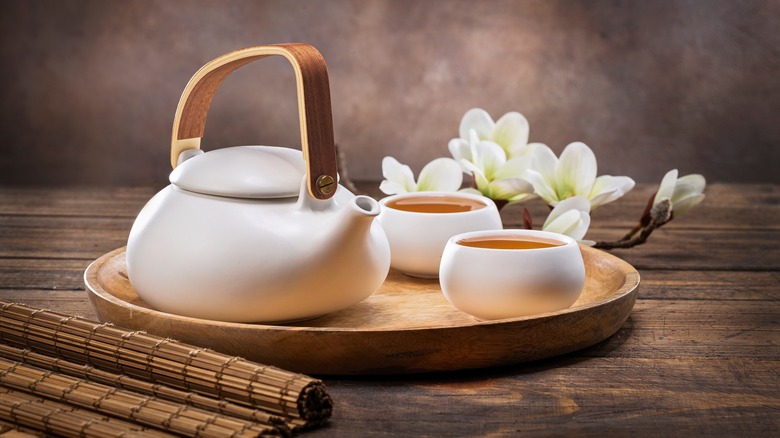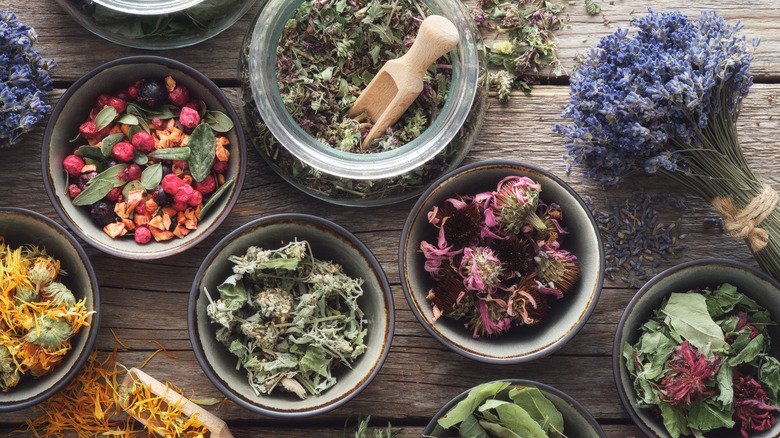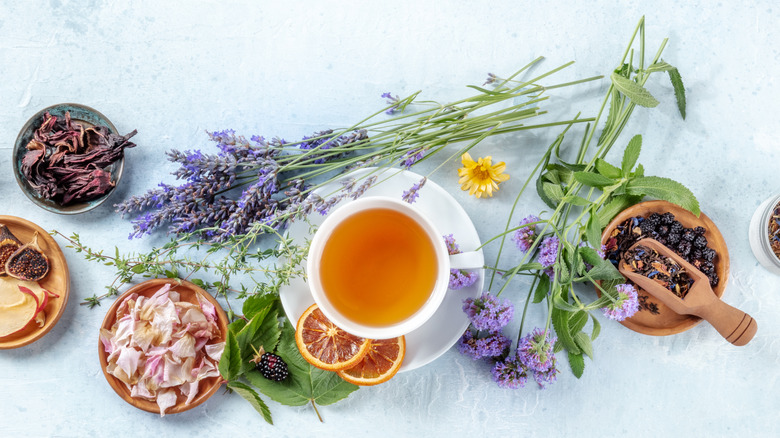Get Creative: Use Leftover Dried Herbs To Amplify Loose Leaf Tea Blends
There's nothing like a cup of tea to start the day — or even end the night. Tea is sometimes associated with the British, but the drink actually originated in China thousands of years ago. Today, tea is enjoyed globally. It is one of the most consumed drinks in the world, even more than coffee and beer.
In fact, herbal tea is growing in popularity among tea drinkers. While you can purchase herbal tea at your nearest grocery store, herbal tea is easy to make — all you need is herbs or any edible plant. Chances are you have cooking herbs in your pantry like basil, parsley, and even garlic, that are perfect for herbal tea. With as little as two ingredients, you can brew herbal tea right from the comfort of your home. Herbs can even be added to a cup of regular tea for an extra boost of flavor.
Some people drink tea for the caffeine, while others may drink it for the taste. If you're the latter and can't consume caffeine, herbal tea is completely caffeine-free. That's because herbal tea is essentially an "infusion or blend of various leaves, fruits, bark, roots, or flowers belonging to almost any edible, non-tea plant," according to the Republic of Tea.
How to dry and use dried herbs
With some dried herbs and water, you can make herbal tea yourself. While you can go all out and make yourself chamomile and peppermint tea, everyday cooking herbs works just as well too. Add garlic powder or dried garlic to herbal tea made with lemon juice and honey. Garlic is known for improving immunity and fighting infections. You can even add herbs like rosemary, thyme, and parsley to loose leaf blends. These herbs also pair well with lemon and honey.
If it's your first time brewing herbal tea, it's recommended to mix one tablespoon of dried herb for every cup of water. Then let it sit in a dark space. How long the herbal tea gets steeped depends on how strong you want the flavor to be. The Chef's Garden recommends steeping herbal tea for five to 10 minutes in water between 160 and 180 degrees Fahrenheit.
You can even go the extra steps and dry herbs yourself. Take your preferred herbs and set them in a ventilated area and they soon dry out. Erda Tea founder Annie Favia-Erickson tells Food & Wine she dry leaves like mint for five days and flowers like chamomile for 10 days. ""We dry in the dark at low temperatures," Favia-Erickson said. "I never want the room to get above 85 degrees because I want to keep all that essential oil, and you're basically slowly dehydrating them."
Herbal tea boast a lot health benefits
Herbal tea has been drunk for centuries and boasted numerous health benefits. In fact, herbal tea, such as peppermint and chamomile, was used for medicinal purposes in Ancient Greece, Egypt, and China, among other civilizations. Drinking herb steeped water was seen as a way to heal and aid the body. In fact, Greek philosopher Dioscorides played a role in studying using herbs and plants as medicine.
Many popular and common herbs have natural, health-promoting compounds, according to Healthline. Chamomile is known for calming, anxiety-reducing, and stressing-reducing effects. The flower is also known to be a natural sleep aid. Another herb, peppermint, is known to help with digestion and aches. Ginger herbal tea can promote anti-inflammation and digestion. It can also help with nausea and constipation. Whether herbal tea you decide to make, there are many everyday herbs that contain many health benefits to pick from that can be transformed into tea.


